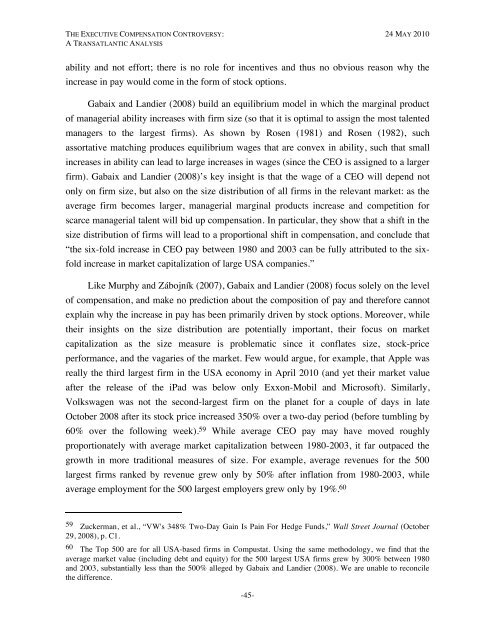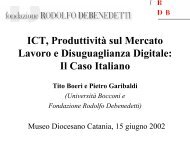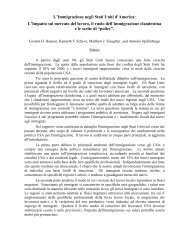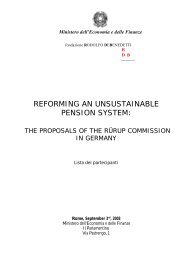The Executive Compensation Controversy - Fondazione Rodolfo ...
The Executive Compensation Controversy - Fondazione Rodolfo ...
The Executive Compensation Controversy - Fondazione Rodolfo ...
Create successful ePaper yourself
Turn your PDF publications into a flip-book with our unique Google optimized e-Paper software.
THE EXECUTIVE COMPENSATION CONTROVERSY: 24 MAY 2010A TRANSATLANTIC ANALYSISability and not effort; there is no role for incentives and thus no obvious reason why theincrease in pay would come in the form of stock options.Gabaix and Landier (2008) build an equilibrium model in which the marginal productof managerial ability increases with firm size (so that it is optimal to assign the most talentedmanagers to the largest firms). As shown by Rosen (1981) and Rosen (1982), suchassortative matching produces equilibrium wages that are convex in ability, such that smallincreases in ability can lead to large increases in wages (since the CEO is assigned to a largerfirm). Gabaix and Landier (2008)’s key insight is that the wage of a CEO will depend notonly on firm size, but also on the size distribution of all firms in the relevant market: as theaverage firm becomes larger, managerial marginal products increase and competition forscarce managerial talent will bid up compensation. In particular, they show that a shift in thesize distribution of firms will lead to a proportional shift in compensation, and conclude that“the six-fold increase in CEO pay between 1980 and 2003 can be fully attributed to the sixfoldincrease in market capitalization of large USA companies.”Like Murphy and Zábojník (2007), Gabaix and Landier (2008) focus solely on the levelof compensation, and make no prediction about the composition of pay and therefore cannotexplain why the increase in pay has been primarily driven by stock options. Moreover, whiletheir insights on the size distribution are potentially important, their focus on marketcapitalization as the size measure is problematic since it conflates size, stock-priceperformance, and the vagaries of the market. Few would argue, for example, that Apple wasreally the third largest firm in the USA economy in April 2010 (and yet their market valueafter the release of the iPad was below only Exxon-Mobil and Microsoft). Similarly,Volkswagen was not the second-largest firm on the planet for a couple of days in lateOctober 2008 after its stock price increased 350% over a two-day period (before tumbling by60% over the following week). 59 While average CEO pay may have moved roughlyproportionately with average market capitalization between 1980-2003, it far outpaced thegrowth in more traditional measures of size. For example, average revenues for the 500largest firms ranked by revenue grew only by 50% after inflation from 1980-2003, whileaverage employment for the 500 largest employers grew only by 19%. 6059 Zuckerman, et al., “VW's 348% Two-Day Gain Is Pain For Hedge Funds,” Wall Street Journal (October29, 2008), p. C1.60 <strong>The</strong> Top 500 are for all USA-based firms in Compustat. Using the same methodology, we find that theaverage market value (including debt and equity) for the 500 largest USA firms grew by 300% between 1980and 2003, substantially less than the 500% alleged by Gabaix and Landier (2008). We are unable to reconcilethe difference.-45-









